Cabernet vs Merlot: Varietal Character is Important, Of Course, But Affected by Vine’s Soil and Climate as Manifest in 13 Appellations Spanning Bordeaux Left & Right Banks (Left-Bank 7-Bottle Package $329) (Right-Bank 6-Bottle Package $269)
Cabernet Sauvignon and Merlot are the horse and carriage of the wine world—the sizzling synergetic symbol of Bordeaux where the whole is greater than the sum of its parts. The two grapes are half-siblings who share a common parent, Cabernet Franc, and often display remarkably similar characteristics depending on where they are grown. When one is used to enhance the other, Merlot brings silken notes of plum and cherry which are brightened by Cabernet’s acidity and toughened by tannins, and where Cabernet shows tobacco and pepper, Merlot pours fruit juice over the parching woodiness.
In Bordeaux, most estates grow both, although in varying percentage based on terroir. In defining this, the intelligentsia often divides the two banks of the Garonne and Gironde Rivers with the Left Bank to the south and the Right Bank to the north. As a general rule, Cabernet Sauvignon vines prefer the gravely soil and slightly warmer climate of the Left Bank, while Merlot vines grow better in the clay and limestone soil of the cooler Right Bank.
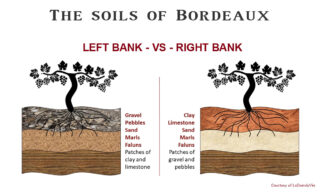
This week’s sampler packages highlight various blends from 13 appellations on both banks; representatives of the marvelous pas de deux that has animated Bordeaux throughout the centuries. Choose one or choose both for a special discounted price.
Left vs Right Bank Appellations: Cabernet vs Merlot
A spoonful of grape sugar helps the geography go down: Bordeaux is host to a body of water called the Gironde Estuary connecting the Atlantic Ocean to two rivers. The river running along the east side of Bordeaux is called the Dordogne and the river on the west side is called the Garonne. These two rivers connect at the base of the Gironde Estuary and fork outwards. The wine regions that are located to the right of the Dordogne River are considered part of the Right Bank while regions located between the two rivers and to the left of the Garonne River are called the Left Bank. All of that underwater turmoil where the two rivers connect contributes to differences in soil composition on the two banks, which can create strikingly different wines.
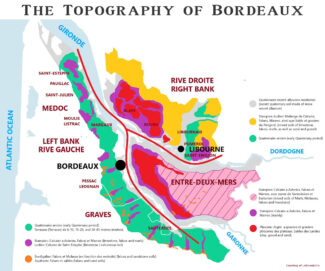
Margaux, for example, has a mixture of soils (gravel with clay and sand) favoring more Merlot and Petit Verdot, but this is not true for the rest of the Médoc. Cabernet Sauvignon prefers the challenge of the rocky, gravelly soil that the Left Bank generally offers; gravel captures and holds heat, helping the area’s wines to develop ripe fruit flavors and those massive tannins that allow wines age for the long haul. On the Right Bank, Merlot is dominant, in part thanks to the limestone plateau of Saint-Émilion. But even there where there is more gravel, you find more Cabernet planted.
The Art of The Blend: Pas de Deux
‘Bordeaux Blend’ is a label-dresser that has been exported across the planet, and people can easily identify the general taste—austere yet opulent, sweet yet dry, acidic yet fruity—of correctly balanced Cabernet Sauvignon and Merlot paired in a bottle.
We are speaking strictly of red wines, of course—white Bordeaux blends also exist, generally Sémillon and Sauvignon Blanc with the occasional addition of Muscadelle. And likewise, the classic Cab/Merlot blend may also include Cabernet Franc, Petit Verdot, Malbec and Carmenère, each of which brings its own housewarming gift to the profile. But the bulk of the blends feature the big two, and although the style has been mimicked on nearly every continent, nowhere is this synergy more vibrant than alone the twin estuaries in the southwest France.
Like most things wine, the art of the blend originates in the vineyard, where soil types and microclimates found within a single property may differ significantly and favor one variety over the other. Equally, different parcels may produce different qualities in the same variety. As a chess master must think many moves ahead, so a vineyard manager, who understands the style of wine the vineyard is intended to ultimately produce, must plant and tend based on a master plan. This varies with the estate, of course, and the consistency from vintage to vintage will necessarily vary, but the house style by which château has built its reputation is often built around a general profile for which it strives in good seasons and bad.
Bordeaux Vintage 2020 Is A Silky Delight
Bordeaux has been as hard hit by global warming as anyone; the summers have been consistently hotter than normal and with less rainfall, or rainfall coming in the unhelpful guise of downpours and hailstorms. 2020 offered a delightful respite.
This is not to say that 2020 was not warm. The first part of the year, which induced an early flowering, was significantly warmer than 2018 or 2019. But the heart of the summer was marginally cooler. When a twelve-month average is taken, 2020 was as warm as the hellish 2018, but not as intensely hot during the summer. But it was wet—2020 saw the highest amount of rainfall between March and September of the past decade, even more than the soggy 2013 and more than 15% above the 30-year average. But a long, dry, two-month period until mid-August was good for the progress of the vine, especially where water reserves in the soil were adequate, or where a clay-based soil was able to retain moisture.
All in all, yields were down slightly in 2020, but the wines are silky and full-fleshed, capable of drinking now, but will improve with age.
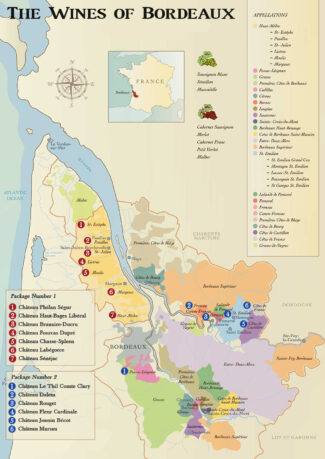
Buy All: A Baker’s Dozen Package ($598)
Like fans of the Yankees and the Mets, the 13 wines in this package are for those who just can’t decide which side of the river in which to invest their loyalty. And that’s as it should be—both versions of Bordeaux offer a unique profile and may be suited to an individual mood, which, like the weather, is ever subject to change.
Cabernet is in the Lead in Left Bank Bordeaux
The Médoc and the Haut-Médoc AOPs are appellations found on the Left Bank of the Gironde, and they produce red wine only. The former is planted equally to Merlot and Cabernet, due primarily to a lower elevation and heavier, clay-dominated soil structure. There are no classified growths within the Médoc AOP, but with increasingly ripe vintages, it offers some of the best value in Bordeaux, even those wines labeled Cru Bourgeois.
The Haut-Médoc is the storybook AOP to the south, whose communes encompass some of the greatest vineyards on earth, here, soils are predominantly gravel, lending much needed warmth for the late-ripening dominant variety, Cabernet Sauvignon, which makes up about 50% of total plantings. Merlot, the second most grown variety, makes up 44%.
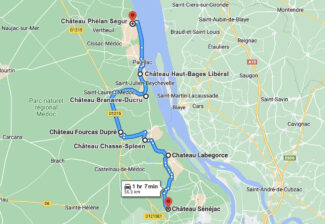
(Left Bank 7-Bottle Package $329)
This collection of top Left Bank wines is meant to showcase Bordeaux’s old guard, AOPs where the most exclusive châteaux are found. These Cabernet-dominant wines tend to be tannic, masculine and capable of aging for many decades and also fetch top dollar prices.
Saint-Estèphe
Located at the northern end of the Haut-Médoc in an undulating sea of quartz, pebbles, clay and limestone, the wines of Saint-Estèphe are known for both finesse and longevity. Accounting for nearly 8% of total Médoc production, the terroir of Saint-Estèphe is considered among the most favorable in Bordeaux—the limestone is ideal for Cabernet Sauvignon, while the heavier, moisture-retaining clay favors Merlot.
Château Phélan Ségur
Château Phélan Ségur is a Saint-Estèphe powerhouse; it neighbors Château Calon-Ségur and Château Montrose. In a 2003 Cru Bourgeois classification revision, it was listed as one of nine Cru Bourgeois Exceptionnels.
A unique property with an Irish founder (Bernard Phelan acquired the Domaine Le Clos de Garamey in 1805 and Ségur de Cabarnac in 1810), the estate remained in the family until 1985—from ‘85 through 2017, it was owned by the Gardinier Group of Xavier Gardinier, with sons Thierry, Stéphane and Laurent at the helm and. Michel Rolland employed as a consulting enologist. In 2017 Belgian Philippe Van de Vyvere, CEO of Sea-Invest, became the new owner of the 220-acre estate which is planted in four plots located on a mosaic of terroirs. The plantings are predominantly Cabernet Sauvignon and Merlot.
As a cultural sidebar, Hannibal Lecter is enjoying a glass of ’96 Château Phélan Ségur in the final scene of the 2001 thriller ‘Hannibal’.
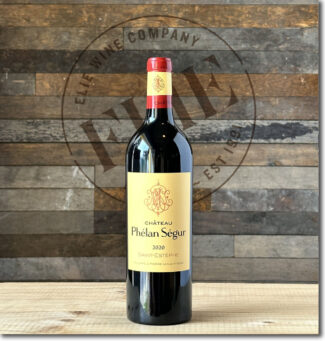 •1• Château Phélan Ségur, 2020 Saint-Estèphe ($59)
•1• Château Phélan Ségur, 2020 Saint-Estèphe ($59)
54% Cabernet Sauvignon, 42% Merlot, 2% Cabernet Franc, 2% Petit Verdot; 2020 is the first vintage of Château Phélan Ségur to be made up of four grape varieties with the appearance of Petit Verdot planted in 2013. The wine is beautifully balanced with powerful notes of blackcurrants, iron, smoked tobacco, chocolate and charred earth.
Pauillac
The most singularly revered appellation on earth; Pauillac is to wine what The Beatles are to pop music. Though fewer than ten square miles in total, three of the top five châteaux in the 1855 Médoc Classification are located here, and so varied is the topography that each estate is able to market the individual nature, in style and substance, of their wares. And it is this trio of skills—growing, producing and selling—that has made the region almost a cliché, synonymous with elite wine, where futures sell for exorbitant rates long before the wine is even in the bottle.
Château Haut-Bages Libéral
This 5th Grand Cru Classé of Pauillac is attached to the vineyards of Château Latour and Pichon Baron. The wines are made under the renowned consultancy of enologist Eric Boissenot.
The vineyard covers 70 acres, half nearby the château on a limestone-rich gravelly ridge and other half on flat land consisting mainly of deep Garonne gravel. The combination of these two types of soil gives Haut-Bages Libéral its iconic character, combining the power of Merlot on limestone clay with the elegance of Cabernets on gravel.
The vineyard is planted to 70% Cabernet Sauvignon and 30% Merlot and is tended to by using ‘lutte raisonnée’—literally ‘reasoned fight’—as a rage against the use of chemicals. Vinification is traditional, in concrete and stainless steel vats in volumes proportional to the plot. All tanks, each with different capacities, are equipped with an automated thermo-regulation system. The wines will then age in barrels for a total of 16 months of which 40% of the barrels are new.
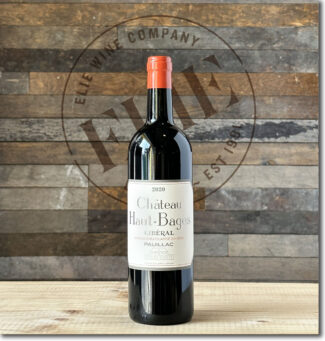 •2• Château Haut-Bages Libéral, 2020 Pauillac ($66)
•2• Château Haut-Bages Libéral, 2020 Pauillac ($66)
78% Cabernet Sauvignon, 22% Merlot. 16 months aging; 40% in new oak barrels, 40% in one-year old barrels, 20% in amphorae. A classic vintage for the estate showing dark forest berries, herbs, blackberries, a hint of cassis and floral nuances swirling through an inviting bouquet. Juicy, elegant and fresh, fine cherry fruit, ripe, supporting tannins, delicate fruit sweetness on the finish, lively style with a subtle honey note on the finish.
Saint-Julien
Great things come in small packages, especially when big money is involved. The smallest of the major Médoc appellations (under four square miles), it also boasts (through a series of real estate deals between the large estates and the small ones) an astonishing pedigree: Fully 95% of the appellation sits on classified acreage. Key to the desirability of the wines produced here is the seamless fusion of concentration and elegance; the wines are of a style historically referred to more masculine, although more in the mode of a Knight Templar than a brawny warrior. This blend of finesse and fortitude comes in part from the preponderance of gravel in the best vineyards, allowing natural drainage in the wet years, radiating warmth in cool vintages, extending the growing season and allowing vine roots to extend deeply into the earth.
Château Branaire-Ducru
The deep gravel terroir (interspersed with clay deposits) makes up Ducru’s 150 acres. The vineyard is planted to 65% Cabernet-Sauvignon, 28% Merlot, 4% Petit Verdot and 3% Cabernet Franc, nearly the same as it was at the time of the 1855 Classification. Originally a part of Chateau Beychevelle, the family-owned estate today relies on a sustainable viticulture system; traditional plowing between the rows depending on soils and the behavior of the vines. Trellising and canopy management are done according to vineyard density and soil composition while vineyards are planted with vines selected in the old vineyards and produced in the nursery. Winemaker Jean-Dominique Videau says, “We are fortunate to be situated in the ‘golden triangle’ of Saint-Julien terroir. Super Second powerhouses are a mere five-minute walk from our humble Fourth Growth estate, and we are capable of producing excellent wines.”
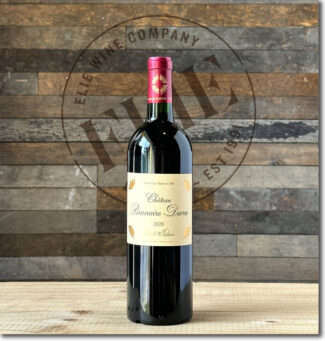 •3• Château Branaire-Ducru, 2020 Saint-Julien ($72)
•3• Château Branaire-Ducru, 2020 Saint-Julien ($72)
58% Cabernet Sauvignon, 32% Merlot, 7% Petit Verdot, 3% Cabernet Franc. A top vintage for this estate, the wine is perfumed and complex, offering cigar box, tobacco, spearmint, wet earth, mocha, spice, black currants and dark cherry.
Listrac-Médoc
Listrac is a small appellation with a big reputation, recognized for producing some of the most iconoclastic (and potentially undervalued) wines in the region, filled with scents of licorice, forest bramble and leather. Listrac-Médoc appellation laws require vineyards to be planted in densities between 6,500 and 10,000 per hectare, which ensures that quality is maintained at the highest levels.
Château Fourcas Dupré
Château Fourcas Dupré combines the name of the locale (the Fourcas plateau) with that of the original owner, Maître Jean Antoine Dupré, who bought the land in 1843. It has changed hands a few times since then, most recently ending up in the possession of Breton entrepreneur and wine aficionado Gérard Jicquel. The soils are primarily Pyrenean gravel, unique to the Médoc, along with chalky clay-limestone subsoil.
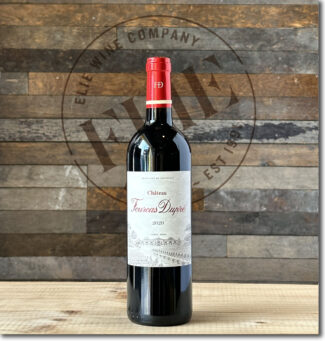 •4• Château Fourcas Dupré, 2020 Listrac-Médoc ($23)
•4• Château Fourcas Dupré, 2020 Listrac-Médoc ($23)
44% Merlot, 44% Cabernet Sauvignon, 10% Cabernet Franc, 2% Petit Verdot. Subtle and refined with fresh blackberry and boysenberry on the nose, showing finely-integrated oak behind its characteristic dusty minerality. Dry and still tannic, the wine can benefit from bottle age.
Moulis-en-Médoc
Moulis is the smallest appellation in the Médoc, situated midway between Saint-Julien and Margaux and south of Listrac-Médoc. Despite the proximity, Moulis has considerably less gravel than Margaux, and that which does exist is mixed with clay and limestone. Wines must be produced from grapes cultivated on designated plots in the parishes of Arcins, Avensan, Castelnau, Cussac, Lamarque, and Listrac to qualify as AOP Moulis appellation. Moulis wines combine finesse, power and complexity and reach their peak at around eight years in the bottle.
Château Chasse-Spleen
This oddly-named estate did, in fact, draw its hyphenated ‘spleen’ from that very organ; the image was inspired by a visit by Lord Byron in 1821, who was so moved that he was quoted saying, “Quel remedy pour chasser le spleen”, which loosely translated means, “What remedy to remove the spleen!”
Ably managed by Claire Villars, this massive 335-acre estate is planted to 52% Cabernet Sauvignon, 39% Merlot, 5% Petit Verdot and 4% Cabernet Franc. Vines average 30 years of age; the terroir is gravel, with clay and chalk soil, but the estate also farms parcels in several different vineyards spread among the various communes in the appellation.
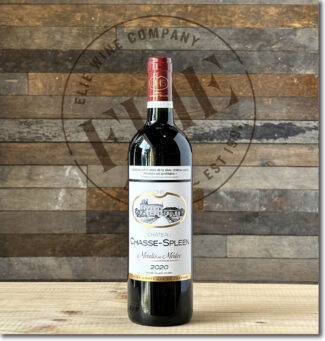 •5• Château Chasse-Spleen, 2020 Moulis-en-Médoc ($41)
•5• Château Chasse-Spleen, 2020 Moulis-en-Médoc ($41)
49% Cabernet Sauvignon, 42% Merlot, 6.5% Petit Verdot, 2.5% Cabernet Franc. The wine displays a bright nose of black cherries, spice box and dried flowers followed by a creamy, medium-bodied palate with fresh and spicy red berry, tea and a bit of olive on the finish.
Margaux
In terms of size and renown, Margaux is a vastly important appellation, with 21 cru classé properties from the 1855 Bordeaux Classification within its borders and more acres under vine than any other Haut-Médoc AOP (except Saint-Estèphe). As feminine as the name sounds, the wines of Margaux, at least by traditional standards are as well, famous for their perfumed fragrance and lilting, delicate expression of terroir. In cooler vintages, they may come across as lightweights compared to the powerhouses of Pauillac, but in fine vintages like 2020, they are incomparable in grace and depth.
Château Labégorce
The first written mention of Labégorce’s vineyards can be found in the oddly named Cocks and Féret guidebook in 1868, dating the winemaking property to 1332. Bordering Châteaux Margaux and Lascombes, the Labégorce estate was purchased by the late Hubert Perrodo in 1989 and is today owned by his daughter Nathalie as part of the family’s portfolio, which also includes Château Marquis d’Alesme and Château Tour de Mons.
Under Perrodo ownership, the percentage of Merlot planted in the 160 acres of vineyard has increased to 45%, since much of the property has clay-rich soils. The vines are, on average, 30 years old, but there are a few parcels planted in the 1950s, and at least one plot that has reached the century mark.
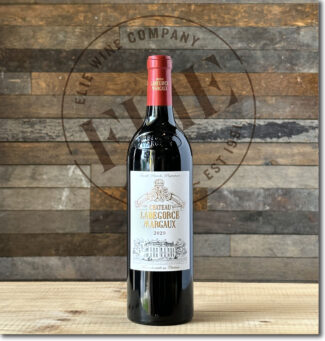 •6• Château Labégorce, 2020 Margaux ($44)
•6• Château Labégorce, 2020 Margaux ($44)
Five beautiful vintages in a row, beginning in 2015, 2020 Labégorce may be the best one yet. 50% Cabernet Sauvignon, 45% Merlot, and the rest Cabernet Franc, it is silky and expressive with layers of black cherry, plum, cassis, licorice, chocolate and a background note of espresso.
Haut-Médoc
Haut-Médoc is a sub-appellation of the Médoc AOP, and represents only a small fraction of Médoc wines. Of the fifteen wine-producing communes of the Haut-Médoc, eight are located along the waterfront of Garonne and Gironde while seven lie inland. Originally an area of salt marsh, most of Haut-Médoc’s early agricultural history involved animal grazing rather than viticulture, so credit is due to 17th century Dutch merchants for engineering a drainage project to convert sufficient marshland into vineyards in order to provide the burgeoning British wine market with an alternative to the Portuguese wines then in vogue. It is fair to say that their mission was accomplished. Still, the climate of Bordeaux is subject to more fluctuation than, say, Oporto, and growers remain beholden to nature.
Château Sénéjac
For an estate that has had an impact in Haut-Médoc for more than five hundred years, there have been relatively few families at the helm. The original owners held on to the property for two centuries, following which, the de Guignes owned Sénéjac from 1860 until 1999 when they sold to Lorraine Cordier, the owner of Château Talbot in St. Julien, Following Lorraine’s death in 2011, the estate was taken over by her sister, Nancy Bignon Cordier.
Originally, Sénéjac was known for producing white Bordeaux, although currently, production is exclusively red. The hundred-acre vineyard, on the far southern end of Haut-Médoc, is planted to 52% Cabernet Sauvignon, 36% Merlot, 8% Cabernet Franc and 4% Petit Verdot.
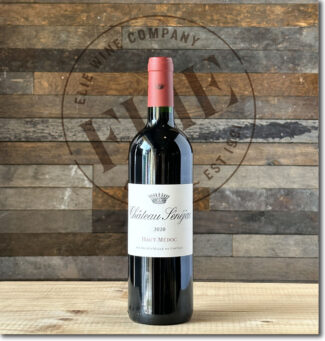 •7• Château Sénéjac, 2020 Haut-Médoc ($25)
•7• Château Sénéjac, 2020 Haut-Médoc ($25)
54% Cabernet Sauvignon, 34% Merlot, 6% Petit Verdot, 6% Cabernet Franc. Black fruits dominate with the focus on blackcurrants, black cherries and plums with a soft undercurrent of cinnamon, chocolate and coffee beans.
Peel a Right Bank Wine, Find a Merlot
There is a sumptuous hedonism associated with descriptions of Right Bank wines that is missing from wines on the opposite bank. Left Bank blends, with a predominance of Cabernet Sauvignon, elicit tasting notes that refer to black tea, tobacco, saddle leather and even tar. Right Bank wines, in contrast, are described with words like chocolate, plum jam, licorice and spice. There is no shortage of exceptions on either side of the Garonne, but in general, the softer, silkier textures of Right Bank are the result of Merlot, the dominant variety in vineyard and assemblages. It is a grape that thrives in the Right Bank’s terroir, which includes plenty of moisture-retaining red clay in relatively flat terrain. Vineyard lands are small, rainfall is scant and summers are hot. Even the Right Bank’s ever-present threat of late frosts work to improve the Merlot by lowering yields and concentrating juice.
Classification is another notable difference: The Left Bank ranks châteaux according to the five-tier 1855 Classification of Bordeaux and uses the Cru Artisans, Cru Bourgeois, and Cru Classés de Graves classification systems.
The Right Bank, on the other hand, uses the 1955 Classification of Saint-Émilion, a ranking system for top producers reviewed every 10 years.
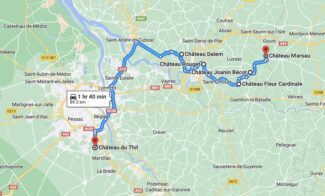
(Right Bank 6-Bottle Package $269)
The popularity of Right Bank did not really explode until Robert Parker Jr. joined the fray and heaped praise and high scores on the modern ‘garagiste’ approach many producers used to make their Merlot blends. This package is a forum for rich, fruity wines with less tannin and acid, wines that are usually quite enjoyable right out of the gate.
Pessac-Léognan
As a stand-alone appellation, Pessac-Léognan is still in the bloom of youth; it was formally established in 1987 in recognition of the truly outstanding long-lived red and white wines of northern Graves. The appellation includes the only red-wine producer outside the Haut-Médoc to be classified in 1855, the Premier Cru Château Haut-Brion. Soils here, as in most of Graves, are filled with gravel and sand, a terroir that favors Cabernet Sauvignon and Cabernet Franc over Merlot.
Château Le Thil Comte Clary
Owned by Florence and Daniel Cathiard, Le Thil is located in the heart of Pessac surrounded by the well-known estates of Châteaux Carbonnieux and Smith Haut Lafitte; Lafitte is also owned by the Cathiards. The vineyards are predominantly Merlot, planted on a superb clay-limestone slope facing due south while some Cabernet Franc is planted on the plateau portion of the estate.
Says Daniel Cathiard: “We make wine according to a unique philosophy: Bio-Précision. We are in the second year of our Organic Agriculture certification, and have added such positive-energy improvements as a CO2 recycling system into baking soda. Grapes are sorted twice, before and after destemming, and are not pressed before undergoing fermentation in vats. Tannins and color are extracted by soft punching down and a few pumping overs, then aged 14 months in barrels (30% new). Perhaps best of all, these barrels are produced in our in-house cooperage.”
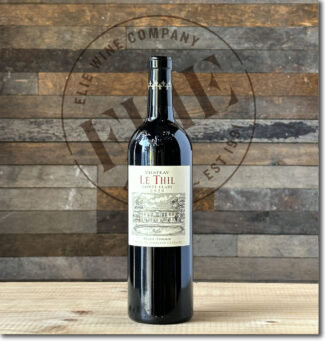 •1• Château Le Thil Comte Clary, 2020 Pessac-Léognan Rouge ($41)
•1• Château Le Thil Comte Clary, 2020 Pessac-Léognan Rouge ($41)
95% Merlot, 5% Cabernet Franc, showing ripe black plum and blackberry on the nose with hints of sous-bois in the background. The palate is seductive, with sweet currant and chocolate-covered cherries building nicely to a finish spiced with clove and cracked black pepper.
Fronsac
Fronsac is known as ‘the Tuscany of the Gironde’ for its spectacular hillside vineyards overlooking the gentle Dordogne and the river Isle. The wines of Fronsac are exclusively red, usually Merlot-based and grown in ‘molasse de Fronsadais’—a subsoil composed of clay and more consistent limestone than neighboring Saint Émilion.
There are around a hundred winemakers currently at work throughout Fronsac’s two thousand vinous acres, and a renaissance in technique and focus throughout the region has raised the quality level of Fronsac wines to a level to which pricing has not yet caught up.
Château Dalem
The seat of Château Dalem is an eighteenth-century house overlooking the valley of L’Isle, directly in front of Pomerol and the slopes of Saint-Émilion. Its vineyard, created in 1610, was owned by the same family for three centuries. In 1955, it was passed on to Michel Rullier, whose daughter Brigitte took over the line in 2002, and continues in this role today.
The 25 acres estate is planted almost exclusively to Merlot, for which the terroir is ideally suited. Says Brigitte, “The average age of our vines 40 years and the grape varieties are 90% Merlot with the rest Cabernet Franc. The diversity of the vats makes it possible to isolate zones of equivalent maturity and to let express as well as possible the different soils. In addition, a careful sorting is carried out on bays by an innovative system that uses air. The aging lasts 18 months and 40% of our barrels are renewed every year. Also, the heaters are chosen to respect the expression of the fruit.”
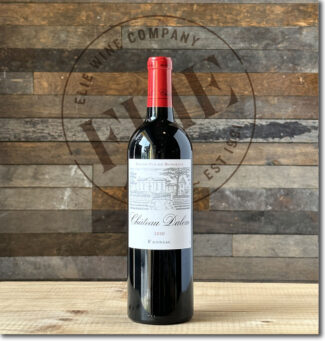 •2• Château Dalem, 2020 Fronsac ($33)
•2• Château Dalem, 2020 Fronsac ($33)
90% Merlot and 10% Cabernet Franc aged for approximately 14 months in French oak barrels, 52% new. The wine shows spectacular depth and focus, with blackberry, raspberry, cedar and light forest floor on the nose; flavors of dark cherry and red currant fruit are laced with a taut, chalky mineral edge.
Pomerol
Lacking a detail-laden history, a focal-point eponymous town, a château-laden landscape or an ancient classification system, Pomerol does not conform to the accepted image of a Bordeaux wine district. Still, despite its tiny size (under 2000 acres), Pomerol has wormed its way onto a prominent perch among the world’s most revered wine regions. Merlot is the dominant grape variety and as a result, the wines tend to be rich, silky and approachable at an early age while also being capable of extended aging. Cabernet Franc is also often present, adding structure and an element of savory spice to the blend. The best wines come from the eastern section of the appellation on the marginally higher land where Pomerol meets Saint-Émilion. It is here that the most famous Pomerol is found, including the château that is more famous than the appellation itself, Pétrus.
Château Rouget
At the end of the 19th century, a classification of Pomerol wines placed Rouget among the top five estates of the appellation, the remarkable constancy showed by consecutive owners of the estate, each of whom produced iconic wines.
The Labruyère Family, who has owned Rouget since 1992, is equally focused. Jean-Pierre Labruyère labored to restore the former glory of this property and in 2008, left the direction to his son, Edouard who is today assisted by estate manager Antoine Ribeiro.
Ribeiro describes Rouget’s situation: “Merlot represents 85% of our vines and is combined with Cabernet Franc, finding here the ideal ripening conditions. Soils can be either composed of clay and gravel or clay and silica with subsoils of iron-rich sandstone. Our vines are currently around 40 years old. A vast replanting program started in 1992 combined with the purchase of 5 high-quality acres from the prestigious neighbouring estates on the high plateau in 1999 have considerably reinforced the position of our Cru.”
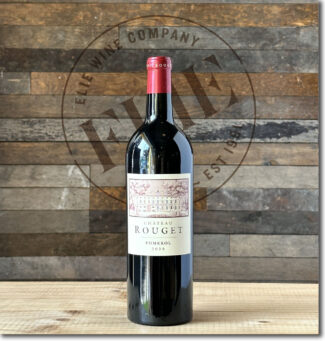 •3• Château Rouget, 2020 Pomerol ($74)
•3• Château Rouget, 2020 Pomerol ($74)
85% Merlot, 15% Cabernet Franc. A powerful Pomerol with notes of crushed blackberries, stewed black plums and Morello cherries along with hints of star anise, pencil shavings and black truffles.
Saint-Émilion
Nowhere in Bordeaux is a genuflection to history more obvious than in Saint-Émilion, which is speckled with Roman ruins and at whose center stands a limestone church built by the region’s namesake, Saint Émilian of Lagny. The vineyards are numerous and small, averaging around fifteen acres and spread across a triad of terroirs that can be roughly defined as a central limestone plateau, the clay and chalk-rich slopes of that plateau and the flatland beyond. What all three topographical areas have in common is cooler soils better suited to Merlot and Cabernet Franc. For the most part, Cabernet Sauvignon does not ripen well in Saint-Émilion except in small pockets, most notably on an ancient alluvial terrace in the northwest, where free-draining gravel soils are similar to those found in the best properties of the Graves and Médoc.
Château Fleur Cardinale
The 60-acre Fleur Cardinale is planted to 75% Merlot, 17% Cabernet Franc and 8% Cabernet Sauvignon at a vine density of 6,500 vines per hectare; new plantings are taking place at 8,000 vines per hectare.
The estate was purchased by Dominique and Florence Decoster in 2001; their children Caroline and Ludovic have taken ever-increasing roles in estate management. Caroline says, “Our vines are old, with an average age of 30 years, with some of our Merlot dating back 70 years. The terroir is dark red clay over limestone soil in the St. Etienne-de-Lisse sector, situated due east of the Saint-Émilion village. The vineyard is ideally situated on a gentle slope, next to the chateau that reaches 75 meters at its peak. We are situated on cooler, late-ripening terroir, which coupled with our drive for picking ripe fruit, often has us as one of the last châteaux on the Right Bank to finish harvesting.”
Her brother Ludovic describes the winemaking: “Vinification takes place in 25 small, thermo-regulated, stainless steel vats—the number of vats is equal to the various parcels of vines. This allows the vinification to be done on a parcel-by-parcel basis. Most of our vats are 70 hectoliters in size, but we use smaller barrels to conduct different experiments, and that wine is often used in the final blend. Additionally, 3% of the harvest is aged in clay amphora.”
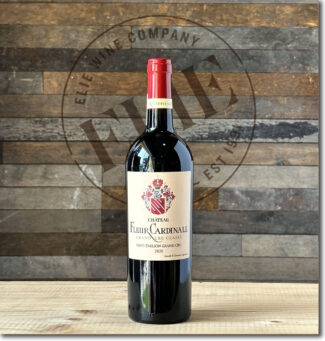 •4• Château Fleur Cardinale, 2020 Saint-Émilion Grand Cru Classé ($53)
•4• Château Fleur Cardinale, 2020 Saint-Émilion Grand Cru Classé ($53)
77% Merlot, 18% Cabernet Franc, 5% Cabernet Sauvignon. Glossy and refined with blueberries and mulberries up front and graphite, dark licorice and crushed stones edging in. The tannin structure starts gently and builds, powering through to the finish.
Francs – Côtes de Bordeaux
The creation of the Côtes de Bordeaux appellation in 2009 was an attempt to unite four lesser-known wine producing areas (Premieres Côtes de Blaye, Côtes de Castillon, Côtes de Francs, and the red wines from the Cadillac district) under a single commercial network. The move has had mixed results, primarily because the identities of each were already well-established locally and these regions are not necessarily near one another. Francs and Castillon are located at the eastern end of the Bordeaux region, while Blaye is in the west and Cadillac in the south.
The banner of each remains distinct, therefore, and the qualities of their individual terroirs are not amenable to a generic appellation name. That can only be determined by a judicious examination of their wines.
Château Marsau
Anne-Laurence and Mathieu Chadronnier are the team behind Marsau; both displayed an insatiable interest in wine from an early age. Today, Mathieu handles the estate’s commercial concerns while Anne-Laurence is the winemaking talent. Mathieu describes his wife like this: “Originally from Brittany, among Anne’s great strengths is a natural affinity with the winds, skies and soils. She has a totally unique way of understanding the symbiotic relationship between wine and its birthplace. She talks lovingly of this magic, and of the wonders created by man and the vine.”
Anne-Laurence herself displays this poetic soul in her description of her estate: “Marsau is a plateau, an unusual, rugged, clay terroir. Our vines are deeply rooted in the earth and here reveal their true expression, sensitive to the intricacies of the soils and landscape, and exposed to the nuances of climate. We cultivate the vines with their true potential guiding our every step; the resulting fruit is of great quality and diversity, as varied as the many facets of the terroir itself. Merlot takes a presiding role in plantings and in our wines is the inimitable hallmark of a sense of place, replete with freshness, depth and intensity. The intrinsic character of the landscape allied with silky tannins.”
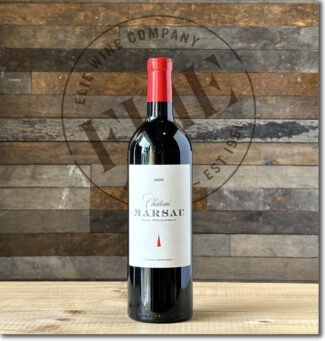 •5• Château Marsau, 2020 Francs – Côtes de Bordeaux ($37)
•5• Château Marsau, 2020 Francs – Côtes de Bordeaux ($37)
100% Merlot, a distinct oddity in Francs, but perfectly explainable by the Chadronnier’s clay-rich terroir. Hints of ginger and cinnamon perfume this plump fruit-forward wine.
Castillon – Côtes de Bordeaux
Castillion is Merlot country; the district, at the very eastern edge of Bordeaux between Libourne and Bergerac (abutting Saint-Émilion) contains multiple clay-rich sites in the foothills of the limestone plateau on which the town Saint-Émilion is located. With over 7000 acres under vine (70% of which is Merlot) the appellation produces only red wine, and nearly all blends with the satellite variety Cabernet Franc, which accounts for 28% of the harvest, and Cabernet Sauvignon, making up a scant 2%.
Geologically, much of the area is an extension of the limestone ridge that runs through Saint-Émilion’s greatest estates, while some sites boast the soil structures of Pomerol. Since the price of land in Castillon remains reasonable, many of the top estates from these storied Bordeaux regions have bought land here and raised the overall quality of the wine. As an example, vineland in Castillon sells for around $10,000 per acre, while in the Grand Cru climats of Saint-Émilion, that same amount of space easily exceeds a million dollars. In total, 230 vignerons and vigneronnes work Castillon terroir.
The area drips with as much history as juice; the Battle of Castillon, which took place on 17 July 1453, marked not only a decisive French victory over England, it signaled the end of the Hundred Years War.
Château Joanin Bécot
The hamlet of Joanin is merely a blink; a row of roadside residential properties in the commune of St-Philippe-d’Aiguilhe. But it has a long history of viticulture due in the main to Château d’Aiguilhe, sitting less than a mile to the south. There is also a lieu-dit called Joanin, and this is the 30-acre vineyard that makes up the estate. At a thousand feet above sea level, this is the highest land along the Gironde, and Juliette Bécot, owner and vigneronne, treats her vines like prize-winning rose bushes, thinking of her Castillon vineyard as a beautiful and refined garden. Also the head of Château Beau-Séjour Bécot in Saint-Émilion, Bécot’s goal is ‘to breathe new life into Bordeaux, crafting elegant, accessible and terroir-driven style wines.’
The vineyard is planted to 75% Merlot and 25% Cabernet Franc; the vines have an average age of 35 years.
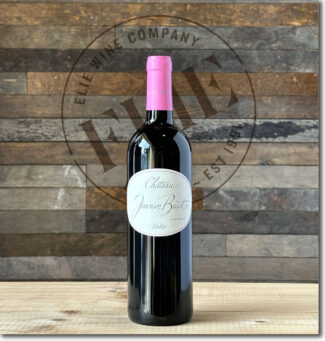 •6• Château Joanin Bécot, 2020 Castillon – Côtes de Bordeaux ($31)
•6• Château Joanin Bécot, 2020 Castillon – Côtes de Bordeaux ($31)
A blend that reflects the plantings, 75% Merlot and 25% Cab Franc; this soft-textured red is redolent with aromas of licorice, loam and blackberry jam with a lush finish showing notes of chocolate-dipped cherries.
- - -
Posted on 2023.08.10 in Margaux, Pessac-Léognan, Graves, Saint-Emilion, Pomerol, Haut-Médoc, Listrac-Médoc, Moulis-en-Médoc, Pauillac, Fronsac, Saint-Estephe, Côtes de Bordeaux, Saint Julien, France, Bordeaux, Wine-Aid Packages
Featured Wines
- Notebook: A’Boudt Town
- Saturday Sips Wines
- Saturday Sips Review Club
- The Champagne Society
- Wine-Aid Packages
Wine Regions
Grape Varieties
Albarino, Albarín Blanco, Albarín Tinto, Albillo, Aleatico, Aligote, Arbanne, Aubun, Barbarossa, barbera, Biancu Gentile, bourboulenc, Cabernet Franc, Caino, Caladoc, Calvi, Carcajolu-Neru, Carignan, Chablis, Chardonnay, Chasselas, Cinsault, Clairette, Corvina, Counoise, Dolcetto, Erbamat, Ferrol, Frappato, Friulano, Fromenteau, Gamay, Garnacha, Garnacha Tintorera, Gewurztraminer, Graciano, Grenache, Grenache Blanc, Groppello, Juan Garcia, Lambrusco, Loureira, Macabeo, Macabou, Malbec, Malvasia, Malvasia Nera, Marcelan, Marsanne, Marselan, Marzemino, Mondeuse, Montanaccia, Montònega, Morescola, Morescono, Moscatell, Muscat, Natural, Niellucciu, Parellada, Patrimonio, Pedro Ximénez, Petit Meslier, Petit Verdot, Pineau d'Aunis, Pinot Blanc, Pinot Gris, Pinot Meunier, Pinot Noir, Pouilly Fuisse, Pouilly Loche, Poulsard, Prieto Picudo, Riesling, Rondinella, Rose, Rousanne, Roussanne, Sagrantino, Sauvignon Blanc, Savignin, Sciacarellu, Semillon, Souson, Sparkling, Sumoll, Sylvaner, Syrah, Tannat, Tempranillo, Trebbiano, Trebbiano Valtenesi, Treixadura, Trousseau, Ugni Blanc, vaccarèse, Verdicchio, Vermentino, Xarel-loWines & Events by Date
- July 2024
- June 2024
- May 2024
- April 2024
- March 2024
- February 2024
- January 2024
- December 2023
- November 2023
- October 2023
- September 2023
- August 2023
- July 2023
- June 2023
- May 2023
- April 2023
- March 2023
- February 2023
- January 2023
- December 2022
- November 2022
- October 2022
- September 2022
- August 2022
- July 2022
- June 2022
- May 2022
- April 2022
- March 2022
- February 2022
- January 2022
- December 2021
- November 2021
- October 2021
- September 2021
- August 2021
- July 2021
- June 2021
- May 2021
- April 2021
- March 2021
- February 2021
- January 2021
- December 2020
- November 2020
- October 2020
- September 2020
- August 2020
- July 2020
- June 2020
- May 2020
- April 2020
- March 2020
- February 2020
- January 2020
- December 2019
- November 2019
- October 2019
- September 2019
- August 2019
- July 2019
- June 2019
- May 2019
- April 2019
- March 2019
- February 2019
- January 2019
- December 2018
- November 2018
- October 2018
- September 2018
- August 2018
- July 2018
- June 2018
- May 2018
- April 2018
- March 2018
- February 2018
- January 2018
- December 2017
- November 2017
- October 2017
- September 2017
- August 2017
- July 2017
- June 2017
- May 2017
- April 2017
- March 2017
- February 2017
- January 2017
- December 2016
- November 2016
- October 2016
- September 2016
- August 2016
- July 2016
- June 2016
- May 2016
- April 2016
- March 2016
- February 2016
- January 2016
- December 2015
- November 2015
- October 2015
- September 2015
- August 2015
- July 2015
- June 2015
- May 2015
- April 2015
- March 2015
- February 2015
- January 2015
- December 2014
- November 2014
- October 2014
- September 2014
- August 2014
- July 2014
- June 2014
- April 2014
- March 2014
- February 2014
- January 2014
- December 2013
- November 2013
- October 2013
- September 2013
- August 2013
- July 2013
- June 2013
- May 2013
- April 2013
- March 2013
- February 2013
- January 2013
- December 2012
- November 2012
- October 2012
Search



